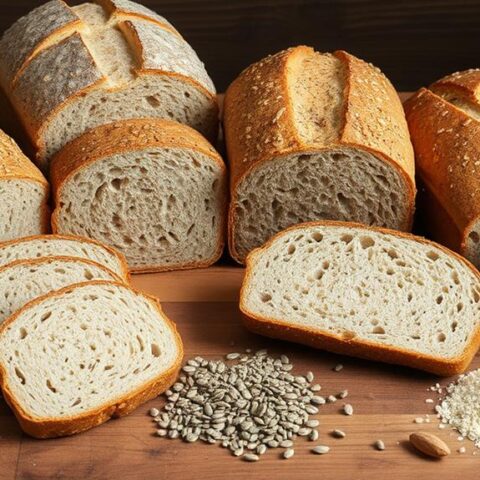
Gluten-free and low-carb diets serve different nutritional purposes and should not be confused. While gluten-free diets eliminate specific proteins found in wheat, barley, and rye, they often contain high levels of carbohydrates from alternative flours and starches. Low-carb diets focus on reducing overall carbohydrate intake to achieve metabolic benefits like improved blood sugar control and weight management. Understanding these distinctions helps individuals make informed dietary choices aligned with their specific health goals and nutritional needs.
Key Takeaways
- Gluten-free and low-carb are distinct dietary approaches – gluten-free eliminates specific proteins, while low-carb focuses on reducing carbohydrate intake.
- Many gluten-free products can contain higher carbohydrate levels than regular foods due to alternative starches and added sugars.
- Gluten-free flours like rice and corn often have higher glycemic indices than wheat flour, potentially raising blood sugar more rapidly.
- Low-carb diets aim for 20-50g carbs daily for ketosis, while gluten-free diets don't restrict carbohydrate amounts.
- Being gluten-free doesn't automatically mean low-carb – careful label reading is essential to monitor carbohydrate content in gluten-free foods.
Defining Gluten Free: Beyond the Basics
While many people associate gluten-free diets with low-carb eating, these dietary approaches serve fundamentally different purposes. A gluten-free diet specifically eliminates gluten-containing foods such as wheat, barley, and rye, primarily to accommodate individuals with celiac disease or gluten sensitivities.
However, this dietary restriction focuses solely on protein content rather than carbohydrate levels.
A gluten-free diet targets specific proteins in certain grains, not the amount of carbohydrates consumed in daily meals.
Many gluten-free alternatives remain carbohydrate-rich, as they often incorporate ingredients like rice flour, corn starch, or other starchy components to achieve similar textures and tastes to traditional wheat-based products.
Understanding this distinction is essential, as those seeking to reduce their carbohydrate intake should not automatically gravitate toward gluten-free options without carefully examining their nutritional content.
The Science Behind Low Carb Eating
The science of low-carb eating centers on two primary metabolic processes: ketosis, where the body shifts to burning fat for fuel when carbohydrate intake is greatly restricted, and improved blood sugar regulation. When following a low-carb diet, insulin levels naturally decrease as the body requires less of this hormone to process incoming carbohydrates. This metabolic adaptation not only supports weight management but also offers potential benefits for individuals managing type 2 diabetes and insulin resistance, as lower insulin levels can help restore the body's natural sensitivity to this essential hormone. Additionally, adherence to a ketogenic diet can lead to a reduction in HbA1c levels, indicating improved glycemic control and less reliance on diabetes medications.
Ketosis and Fat Burning
Understanding ketosis reveals fascinating insights into how the human body adapts to different fuel sources for energy production. When carbohydrate intake drops considerably, typically to 20-50 grams daily, the body shifts into a state of ketosis, where it primarily burns fat for fuel instead of glucose.
During this metabolic shift, the liver converts fatty acids into ketones, providing an alternative energy source for the brain and body. Low-carb diets trigger this process by reducing insulin levels, which accelerates fat burning and often leads to rapid weight loss.
Research demonstrates that this metabolic state can improve various health markers, including blood sugar control and cholesterol profiles. While the initial shift may cause temporary discomfort known as "keto flu," many people experience enhanced metabolic health once fully adapted to fat burning.
Blood Sugar and Insulin
Blood sugar and insulin dynamics fundamentally shape how low-carb diets influence metabolic health. By restricting carbohydrate intake, these diets naturally reduce glucose levels in the bloodstream, leading to decreased insulin production and improved insulin sensitivity.
Research demonstrates that individuals following low-carb diets experience significant reductions in both blood sugar and insulin levels, with studies showing up to 50% lower insulin requirements.
It's important to note that while gluten-free foods eliminate wheat proteins, they don't necessarily impact blood sugar and insulin levels in the same way as low-carb diets.
Many gluten-free products can still be high in carbohydrates, potentially affecting metabolic health. The key distinction lies in carbohydrate content rather than gluten status, making it essential to understand that gluten-free doesn't automatically equate to better blood sugar control.
Common Misconceptions About Gluten Free Foods
Many gluten-free products contain hidden sugars and starches that consumers might overlook when focusing solely on the "gluten-free" label.
Manufacturers often compensate for the missing gluten by adding extra sweeteners, refined starches, and binding agents to improve texture and taste in gluten-free items.
Careful examination of nutrition labels reveals that gluten-free alternatives frequently pack more carbohydrates than their conventional counterparts, making them potentially problematic for those seeking to reduce their carbohydrate intake.
Hidden Sugars in Substitutes
A common misconception about gluten-free products stems from their perceived health benefits, yet these substitutes often harbor significant amounts of hidden sugars and refined carbohydrates.
Research shows that processed foods marketed as gluten-free can contain up to 60% more carbohydrates than their conventional counterparts, primarily due to added sugars used to enhance taste and texture.
Many gluten-free flours and substitutes, particularly those made from rice or corn, have higher glycemic indices than whole grain alternatives, leading to rapid blood sugar spikes.
To avoid these hidden sugars, consumers should carefully examine nutritional labels on gluten-free products. Understanding that "gluten-free" doesn't automatically mean healthier or lower in carbohydrates is vital for making informed dietary choices.
Read Labels More Carefully
Understanding gluten-free labels requires careful attention to detail, as these products often contain complex carbohydrate profiles that can surprise consumers.
When examining processed gluten-free foods, shoppers should focus on the nutritional panel, particularly serving sizes and total carbohydrate content, rather than just looking for the gluten-free certification.
Many consumers following a gluten-free diet mistakenly assume these products align with low-carb goals, but alternative flours like rice and corn can contribute significant carbohydrates.
The presence of added sugars and starches in gluten-free foods often results in carbohydrate levels comparable to conventional products.
To make informed choices, consumers must read labels thoroughly, paying special attention to ingredients lists and understanding that "gluten-free" doesn't automatically mean fewer carbohydrates or better nutritional value.
Breaking Down Carbohydrate Content in Gluten Free Products
When examining gluten-free products, consumers often discover that these items contain comparable or even higher levels of carbohydrates than their traditional counterparts.
Gluten-free products frequently rely on alternative flours like rice, corn, and potato starch, which can be high in carbohydrates. A single slice of gluten-free bread typically contains 15-25 grams of carbohydrates, making it potentially unsuitable for low-carb diets.
Alternative flours used in gluten-free products often contain high carbohydrate levels, with a single bread slice packing up to 25g of carbs.
While some gluten-free alternatives like almond and coconut flour offer lower carbohydrate options, these ingredients aren't commonly used in commercial gluten-free products.
The addition of sugars and starches to improve texture and taste further increases the carbohydrate content. Understanding this reality emphasizes the importance of carefully reviewing nutritional labels when selecting gluten-free items, particularly for those monitoring their carbohydrate intake.
Health Benefits and Limitations of Each Diet
While gluten-free diets primarily address specific medical conditions like celiac disease, low-carb diets offer broader metabolic benefits including improved blood sugar control and weight management. Both dietary approaches present distinct nutritional challenges, with gluten-free dieters needing to monitor B-vitamin and fiber intake, while low-carb followers must carefully balance their protein and fat consumption. The effectiveness of each diet depends largely on individual health needs, as gluten-free diets focus on eliminating specific proteins rather than promoting weight loss, whereas low-carb diets actively target weight reduction through metabolic changes. Additionally, ketogenic diet enhances insulin sensitivity, which is crucial for managing Type 2 diabetes and stabilizing insulin mechanisms.
Medical Impact and Results
Despite their frequent association in popular media, gluten-free and low-carb diets produce markedly different medical outcomes and serve distinct therapeutic purposes.
Research shows that gluten-free diets primarily benefit individuals with specific health problems like celiac disease and gluten sensitivity, but may lead to nutrient deficiencies if not carefully planned.
In contrast, low-carb diets demonstrate consistent effectiveness for weight loss and metabolic improvements across broader populations.
Clinical studies indicate that following a gluten-free diet without medical necessity does not automatically confer health benefits, particularly when relying on processed alternatives.
These products often contain high levels of refined carbohydrates and fewer nutrients than their conventional counterparts.
Meanwhile, low-carb diets have shown measurable improvements in blood sugar control, body composition, and satiety levels.
Weight Control Effectiveness
The effectiveness of gluten-free and low-carb diets for weight control presents distinctly different outcomes based on scientific research.
Studies consistently show that low-carb diets typically yield better weight loss results in healthy individuals, primarily due to their ability to reduce hunger and promote fat burning.
While a gluten-free diet may benefit those with celiac disease or gluten sensitivity, it does not inherently support weight control in the general population.
Research indicates that simply eliminating gluten without addressing overall dietary quality may not lead to weight loss, as many gluten-free processed foods contain similar or higher caloric content than their conventional counterparts.
For sustainable weight control, both approaches should emphasize whole, minimally processed foods, though low-carb diets generally demonstrate superior effectiveness for weight management in individuals without gluten-related conditions.
Nutrient Balance Comparison
Understanding the nutrient balance between gluten-free and low-carb diets reveals significant differences in their nutritional profiles and potential health impacts.
While both approaches can support specific health goals, they differ considerably in their nutrient composition and potential risks.
Key nutritional considerations for each diet:
- Gluten-free diets can include nutrient-rich carbohydrates from fruits, vegetables, and alternative grains like quinoa.
- Low-carb diets emphasize healthy fats and proteins while limiting carbohydrate-rich foods.
- Both diets risk nutrient deficiencies without proper planning and whole food choices.
- Replacing whole grains requires careful attention to obtain essential vitamins and minerals.
The best approach depends on individual health needs, with gluten-free diets being essential for those with celiac disease, while low-carb diets may better serve those seeking metabolic health improvements.
Reading Food Labels: What to Look For
Managing food labels requires careful attention to detail when seeking gluten-free and low-carb options. Consumers should first examine the ingredient list for gluten-containing grains like wheat, barley, and rye. The presence of certified gluten-free labels confirms products meet FDA standards of 20 ppm or less of gluten.
When reviewing nutritional information, it's essential to check carbohydrate content, as gluten-free products often contain alternative flours that can be high in carbs.
Terms such as "wheat-free" shouldn't be mistaken for gluten-free certification, as gluten may still be present in other ingredients. Additionally, food labels may include allergen statements indicating potential cross-contamination, which is vital information for those with celiac disease or severe gluten sensitivities.
Popular Gluten Free Foods and Their Carb Content
Beyond careful label reading, consumers should be aware that many popular gluten-free foods contain significant carbohydrate content, often matching or exceeding their gluten-containing counterparts.
Common gluten-free foods and their typical carbohydrate profiles include:
- Gluten-free pasta made from corn or rice contains 40-50 grams of carbs per serving.
- Rice and quinoa-based products possess similar carbohydrate levels to wheat-based alternatives.
- Gluten-free baked goods often incorporate high-carb ingredients like added sugars and starches.
- Gluten-free snacks frequently contain refined carbohydrates and sugars for improved taste and texture.
While alternative grains like buckwheat, millet, and amaranth offer different nutritional profiles, they still contribute substantial carbohydrates to the diet.
High-carb breakfast foods like traditional cereals and oatmeal should also be avoided by those monitoring carb intake, as they often have 20-30 grams of carbs per serving.
Understanding these carbohydrate contents helps consumers make informed dietary choices, particularly for those monitoring their carb intake.
Making Smart Dietary Choices for Your Goals
Making informed dietary choices requires a clear understanding of personal health objectives, whether they involve managing celiac disease, losing weight, or improving overall wellness. Before selecting gluten-free products, consumers should carefully examine nutrition labels to compare carbohydrate content, protein levels, and other key nutrients that align with their specific goals. This targeted approach helps distinguish between products that merely satisfy gluten-free requirements and those that genuinely support broader health and nutrition objectives. It's crucial to understand the difference between total and net carbohydrates, as this can significantly impact dietary adherence, especially for those following a keto lifestyle.
Know Your Health Goals
When establishing dietary preferences, it becomes essential for individuals to clearly define their health objectives before deciding between gluten-free and low-carb eating patterns. Understanding personal health goals helps determine the most appropriate dietary approach, as these two diets serve different purposes and yield distinct outcomes.
Consider these key factors when determining your dietary path:
- Medical necessity – addressing celiac disease or gluten sensitivity
- Weight management goals and metabolic health targets
- Overall nutrition content requirements and dietary restrictions
- Long-term sustainability and lifestyle compatibility
For those with gluten sensitivity, following a gluten-free diet is non-negotiable, regardless of carbohydrate content.
However, individuals primarily focused on weight loss might find a low-carb diet more aligned with their objectives, as it specifically targets carbohydrate reduction rather than gluten elimination.
Compare Nutritional Values First
Smart dietary choices begin with a thorough examination of nutritional values, particularly when maneuvering between gluten-free and low-carb options. Understanding nutritional labels is essential, as gluten-free products often contain comparable carbohydrate levels to their conventional counterparts, especially in processed foods like breads and pastas.
When comparing products, consumers should focus on the total carbohydrates listed on nutritional labels rather than just seeking gluten-free certification. Many gluten-free alternatives are made with high-carb ingredients like rice flour or corn starch.
For those monitoring carbohydrate intake, emphasizing whole foods in their natural state provides better control over dietary choices. Fresh vegetables, lean proteins, and minimally processed gluten-free options typically offer superior nutritional profiles compared to their heavily processed counterparts.
The Role of Alternative Flours and Starches
A wide variety of alternative flours and starches play a considerable role in gluten-free baking, each bringing distinct properties and carbohydrate profiles to the final product.
When creating gluten-free products, manufacturers often combine multiple flours and starches to achieve textures similar to traditional wheat-based foods, though these combinations can result in high-carb foods that may surprise consumers.
Common gluten-free baking ingredients include:
- Almond flour – relatively lower in carbs but higher in healthy fats
- Coconut flour – high in fiber but requires more liquid in recipes
- Tapioca flour – provides elasticity but is high in carbohydrates
- Potato starch – adds moisture but considerably increases carb content
Careful examination of nutritional labels reveals that many gluten-free products contain substantial amounts of carbohydrates due to these alternative ingredients, making them comparable to or sometimes higher in carbs than conventional options. Psyllium Husk Powder can also be used in gluten-free baking to enhance texture and add fiber without significantly increasing the carbohydrate content.
Weight Management on Gluten Free Vs Low Carb Diets
Understanding the impact of dietary choices on weight management requires careful consideration of both gluten-free and low-carb approaches.
While gluten-free diets are essential for those with Celiac disease, they don't inherently promote weight loss, as many gluten-free alternatives can be high in calories and carbohydrates. Studies show that simply eliminating gluten without monitoring caloric intake may even lead to weight gain.
Low-carb diets, in contrast, specifically target reduced carbohydrate consumption while emphasizing protein and healthy fats, often resulting in decreased hunger and lower overall caloric intake. Ketosis enhances fat oxidation, leading to increased fat burning and reduced hunger, which can support weight management.
Research indicates that successful weight management depends more on maintaining a balanced caloric deficit over time rather than following either dietary approach exclusively.
The key lies in making mindful food choices and monitoring portion sizes, regardless of whether following a gluten-free or low-carb regimen.
Medical Reasons for Following Each Diet
Medical necessity drives the adoption of gluten-free and low-carb diets for distinctly different health conditions. Medical professionals prescribe these dietary approaches based on specific diagnoses and patient symptoms. Understanding the medical reasons for each diet helps individuals make informed decisions about their nutritional needs. Key medical conditions requiring specific diets include:
- Celiac disease requires a strict gluten-free diet to prevent intestinal damage
- Non-celiac gluten sensitivity necessitates gluten avoidance to minimize discomfort
- Gastrointestinal issues like IBS may improve with gluten restriction
- Diabetes and metabolic disorders often benefit from low-carb diets
Women with conditions like PCOS and endometriosis may experience worsened symptoms due to hormonal disruptions associated with low-carb diets. While gluten-free diets address specific protein-related conditions, low-carb diets target blood sugar regulation and metabolic health. Each dietary approach serves unique medical purposes and should be followed under professional guidance.
Nutritional Considerations and Deficiency Risks
While both gluten-free and low-carb diets serve specific medical purposes, they come with distinct nutritional challenges that require careful attention.
Following a gluten-free diet without proper planning can lead to significant nutrient deficiencies, particularly in fiber, iron, and B vitamins typically found in whole grains. Many processed gluten-free alternatives are made with refined flours that lack essential nutrients and may contain higher levels of sugars and unhealthy fats.
Gluten-free diets require careful planning to avoid nutrient gaps, as many alternatives lack essential vitamins and contain excess sugars.
Maintaining a balanced diet becomes particularly important when eliminating gluten-containing foods. The absence of dietary fibers commonly found in whole grains can impact digestive health, while inadequate nutrient intake may increase the risk of conditions like anemia and osteoporosis.
These potential deficiencies underscore the importance of careful meal planning and possible supplementation when following a gluten-free regimen. Additionally, stable blood sugar levels are crucial for those managing diabetes on a low-carb diet, as it reduces the risks of hyperglycemic episodes.
Meal Planning Strategies for Both Diets
Successfully planning meals that accommodate both gluten-free and low-carb requirements demands careful attention to ingredient selection and preparation methods.
Effective meal planning involves choosing protein-rich foods while incorporating gluten-free alternatives that align with low-carb goals.
Key strategies for combining these dietary approaches include:
- Focusing on naturally gluten-free proteins like eggs, fish, and lean meats
- Selecting low-starch vegetables such as spinach, broccoli, and cauliflower
- Using alternative gluten-free flours like almond or coconut flour for baking
- Incorporating healthy fats from avocados, nuts, and olive oil
When preparing meals, it's crucial to read nutrition labels carefully, as many gluten-free foods can be high in carbohydrates.
Choosing whole, unprocessed ingredients and balancing portions helps guarantee both dietary requirements are met while maintaining nutritional adequacy. A key consideration is understanding the benefits of reduced hunger and cravings that can arise from low-carb, nutrient-dense meals.
Cross-Over Foods That Work for Both Diets
Finding foods that satisfy both gluten-free and low-carb requirements can be simpler than many people expect. Natural whole foods form the foundation of both dietary approaches, with numerous options available for those managing gluten intolerance while following low-carb diets. Many nutritious whole grains like quinoa and buckwheat offer gluten-free alternatives that can fit into a low-carb lifestyle when portioned appropriately. A variety of keto-friendly foods like avocados and dark chocolate can complement both dietary needs.
| Food Category | Examples |
|---|---|
| Proteins | Eggs, Fish, Poultry, Meat |
| Flours | Almond Flour, Coconut Flour |
| Vegetables | Leafy Greens, Cauliflower |
| Snacks | Nuts, Seeds, Olives |
These versatile ingredients allow for creative meal planning while maintaining dietary restrictions. Alternative flours provide excellent substitutes for traditional wheat-based products, enabling the creation of both gluten-free foods and low-carb versions of favorite recipes.
Long-Term Success and Sustainability Tips
Maintaining a sustainable gluten-free or low-carb lifestyle requires thoughtful planning and practical strategies that extend beyond initial dietary changes. Success depends on developing consistent habits and making informed choices about nutrition and meal preparation.
Key strategies for long-term dietary success include:
- Focus on whole foods rather than processed gluten-free alternatives
- Implement regular meal planning and preparation routines
- Master portion sizes to maintain balanced nutrition
- Develop cooking skills to create satisfying gluten-free meals
Whether following a gluten-free diet or low-carb diet, sustainability comes from creating a practical approach that fits into daily life.
Frequently Asked Questions
Does Gluten-Free Take Away Carbs?
Gluten-free alternatives don't reduce carb content, as many still contain high levels of carbohydrates. Food labeling shows nutritional values remain similar, dispelling health misconceptions about gluten-free products automatically being low-carb.
Does Gluten-Free Pasta Have Less Carbs Than Regular Pasta?
Gluten-free pasta alternatives often contain similar or higher carb content compared to regular pasta. While ingredient choices vary, most gluten-free pasta made from rice or corn maintains comparable nutritional composition regarding carbohydrates.
Does Gluten-Free Really Make a Difference?
Gluten-free diets make a significant difference for people with gluten sensitivity symptoms or celiac disease. For others without these conditions, health benefits of gluten-free alternatives and grains are minimal to nonexistent.
Does Gluten-Free Mean Low-Carb?
Gluten-free grains can contain high carb content, comparable to regular grains. Common health misconceptions equate gluten-free with low-carb, but dietary choices require careful review of nutritional labels for accurate carbohydrate assessment.
Conclusion
Understanding the distinction between gluten-free and low-carb diets is essential for making informed nutritional choices. While these dietary approaches serve different purposes, they can complement each other when implemented thoughtfully. Success with either diet depends on careful meal planning, nutritional awareness, and sustainable lifestyle changes. By focusing on whole, nutrient-dense foods and maintaining balanced nutrition, individuals can effectively follow either or both dietary patterns while meeting their health goals.










No Comments